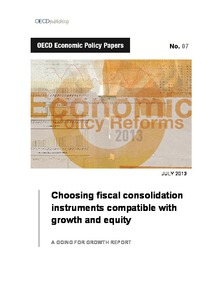Choosing fiscal consolidation instruments compatible with growth and equity
"Despite sustained efforts made in recent years to rein in budget deficits, a majority of OECD countries still face substantial public finance consolidation needs moving forward, owing to the legacy of debt accumulation before the crisis, and to the role played by fiscal policy in rescuing the...
| Main Authors: | , , , |
|---|---|
| Institution: | ETUI-European Trade Union Institute |
| Format: | TEXT |
| Language: | English |
| Published: |
Paris
2014
OECD |
| Subjects: | |
| Online Access: | https://www.labourline.org/KENTIKA-19110289124919384619-Choosing-fiscal-consolidation-.htm |
| Summary: | "Despite sustained efforts made in recent years to rein in budget deficits, a majority of OECD countries still face substantial public finance consolidation needs moving forward, owing to the legacy of debt accumulation before the crisis, and to the role played by fiscal policy in rescuing the banking system and supporting aggregate demand in the aftermath of the recession. Further budget consolidation is also needed over a much longer horizon to face long-term public spending pressures, in particular from pensions and health care.
Fiscal consolidation complicates the task of achieving other policy goals. In most cases, it weighs on demand in the short term. And, if too little attention is paid to the mix of instruments used to achieve consolidation, it can slow the process of global rebalancing, undermine long-term growth and exacerbate income inequality. It is therefore important for governments to adopt consolidation strategies that minimise these adverse side-effects. The analysis assesses the near and long-term consolidation needs for OECD countries and proposes consolidation strategies that take into account other policy goals as well as country-specific circumstances and preferences. To do so, increases in particular taxes and cuts in specific spending areas are assessed for their effects on short- and longterm growth, income distribution and external accounts. The results of detailed simulations indicate that a significant number of OECD countries may have to raise harmful taxes or cut valuable spending areas to deliver sufficient consolidation, underscoring the need for structural reforms to counteract these side-effects." |
|---|---|
| Physical Description: | 42 p. Digital |

